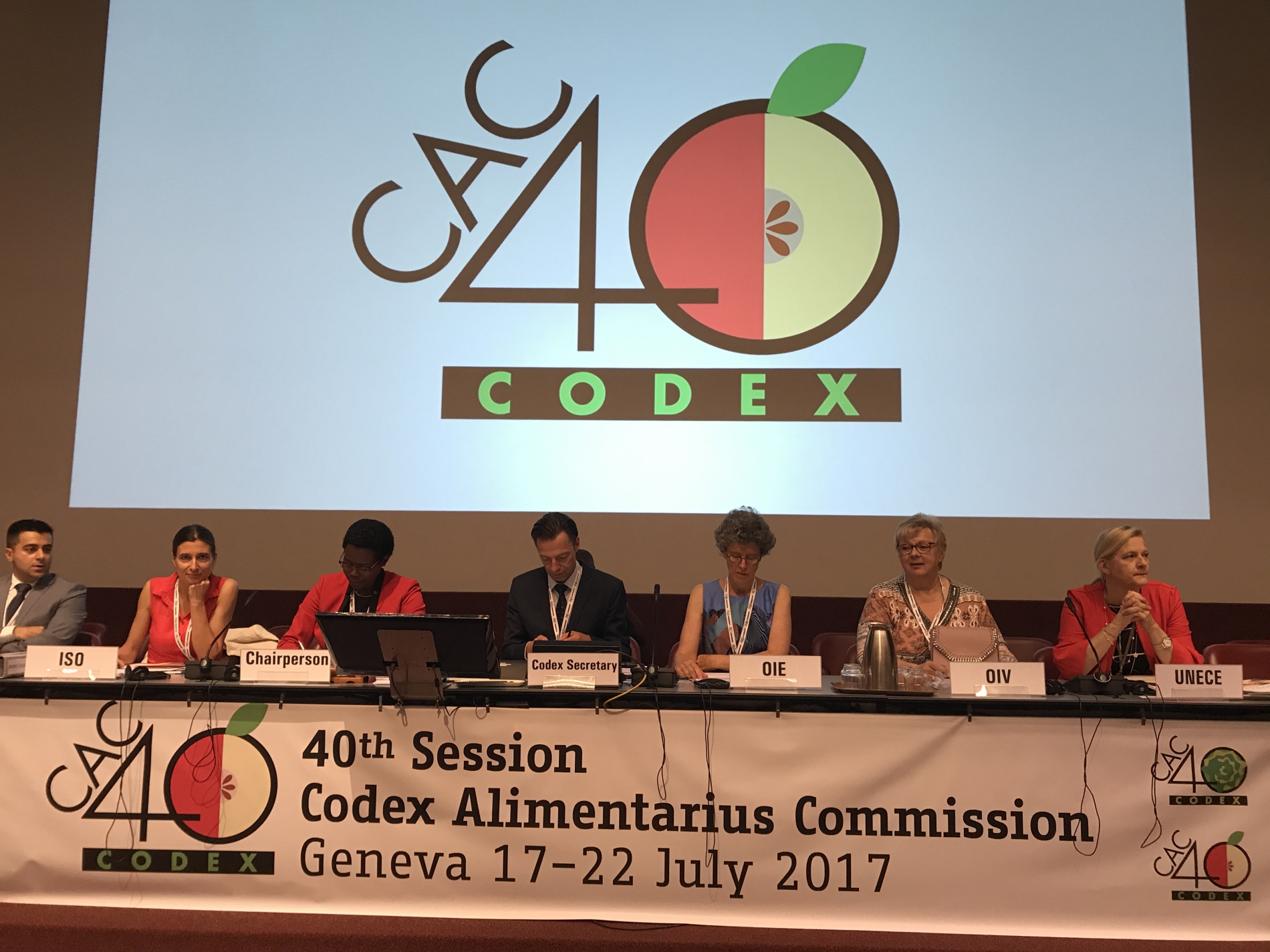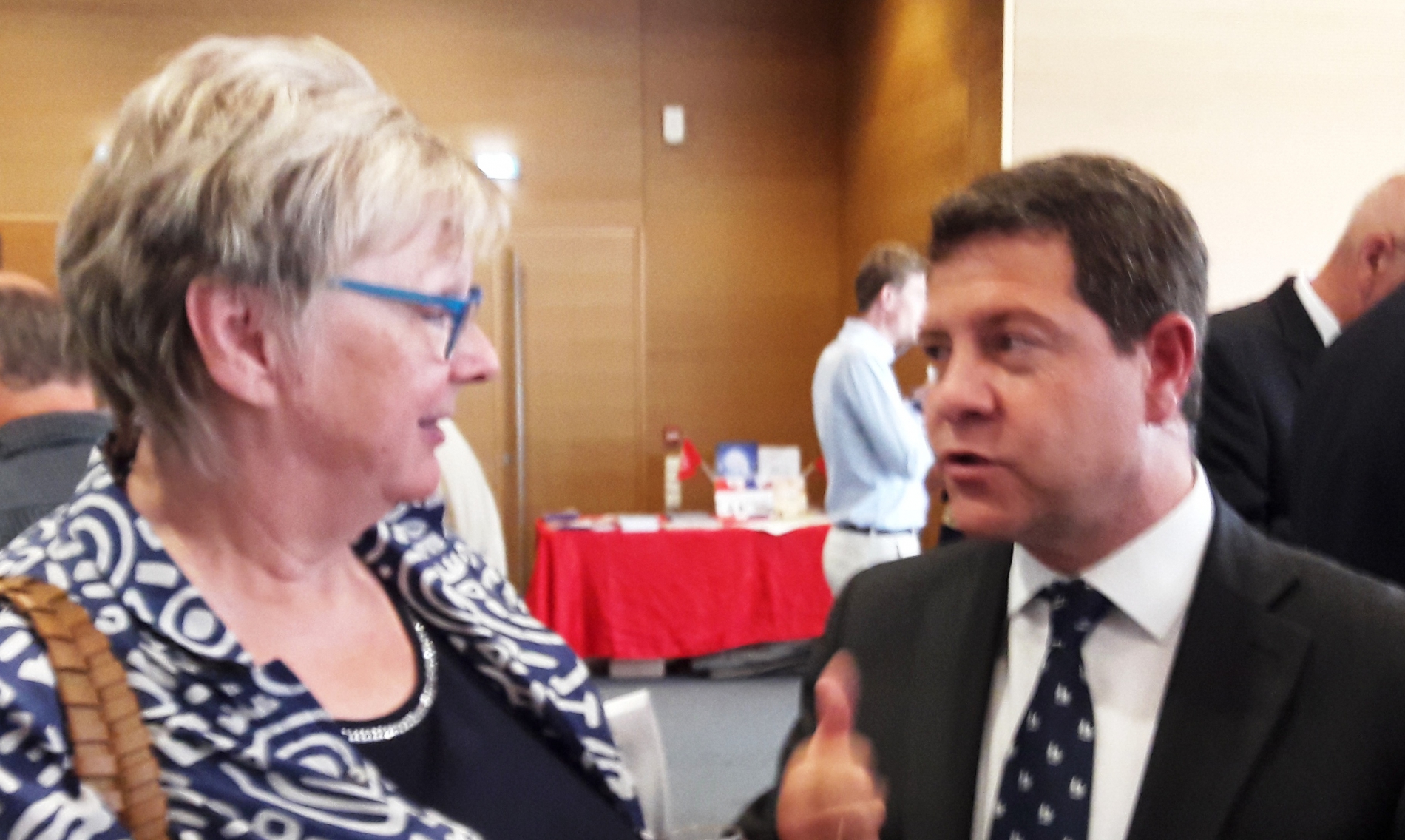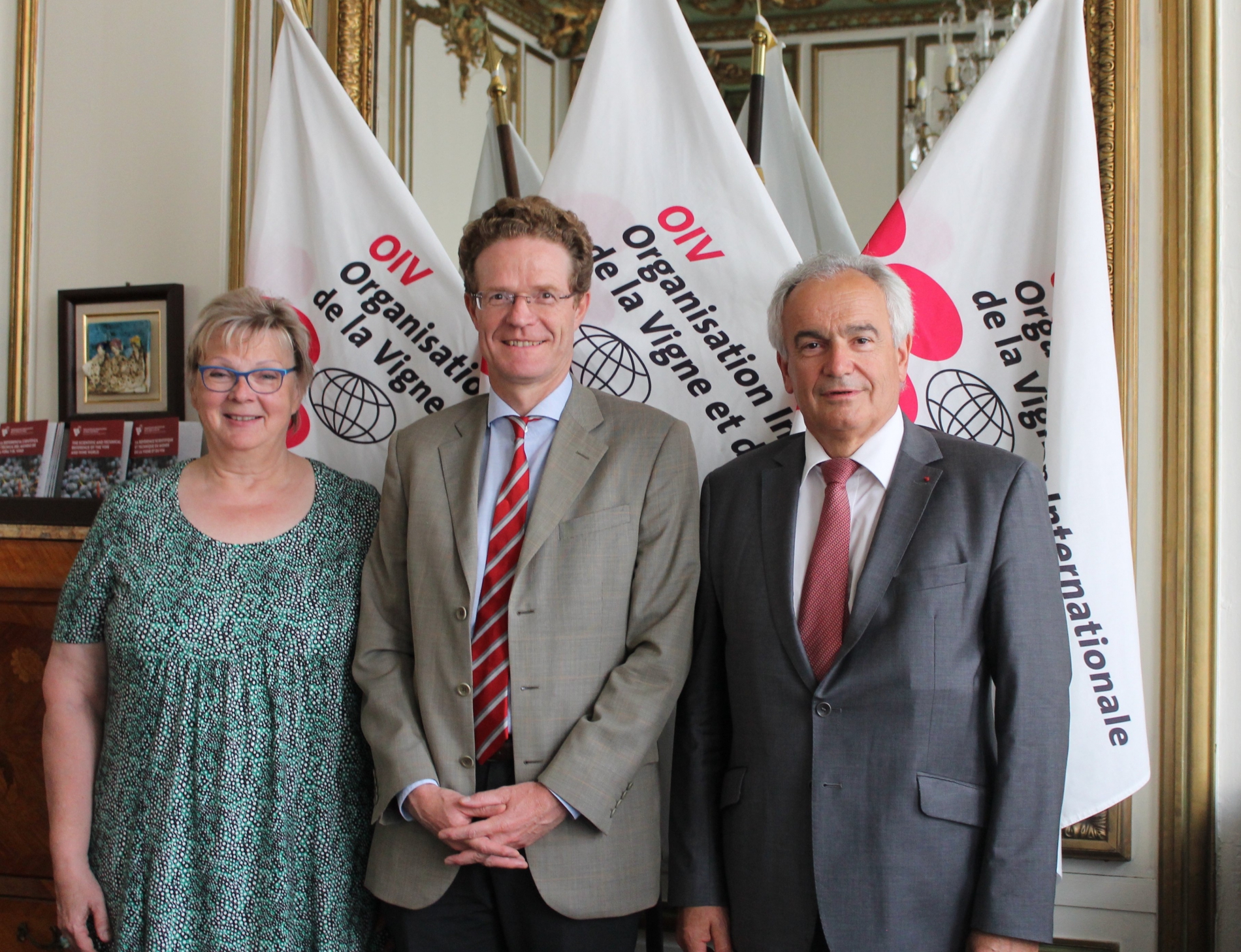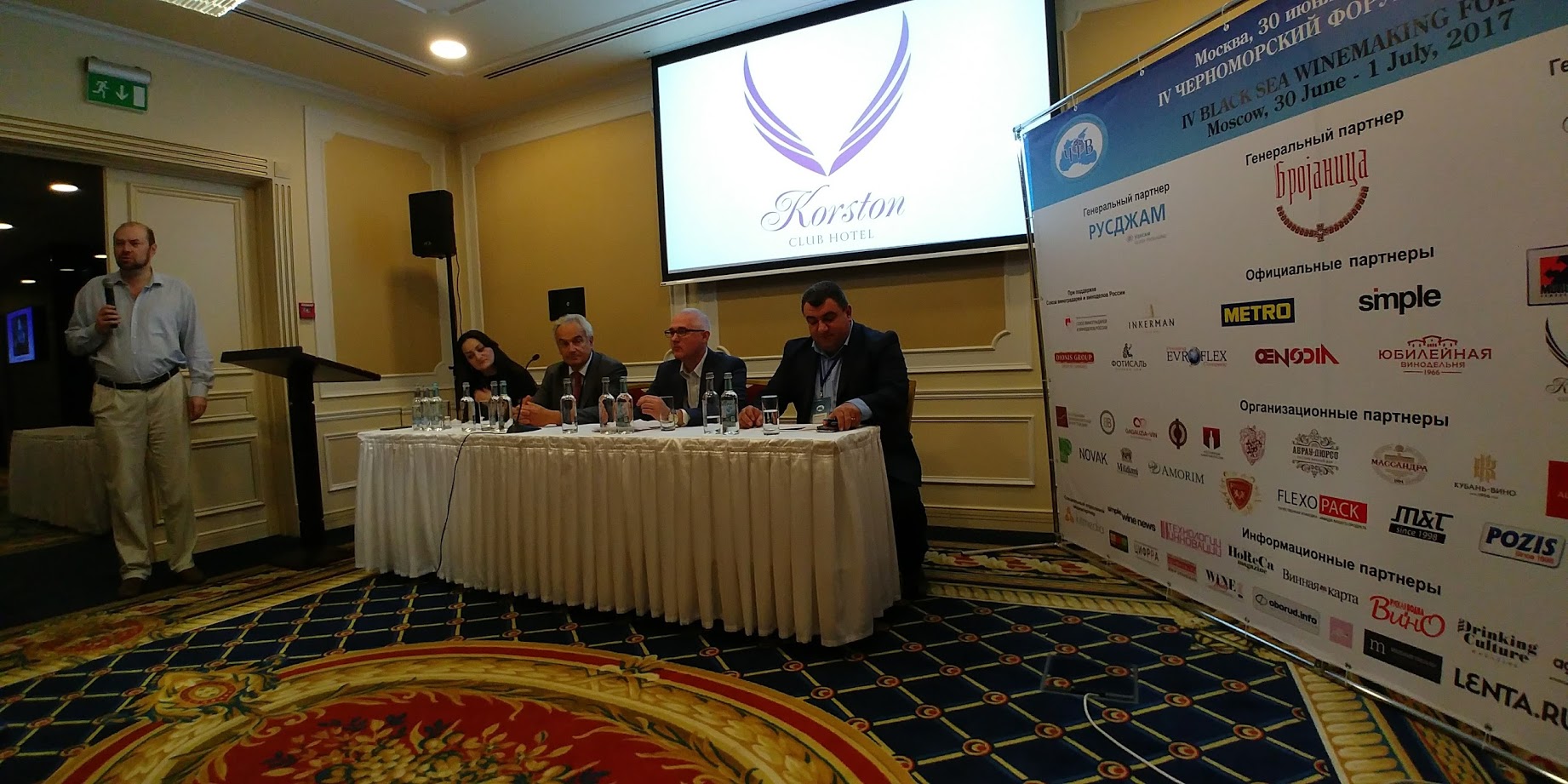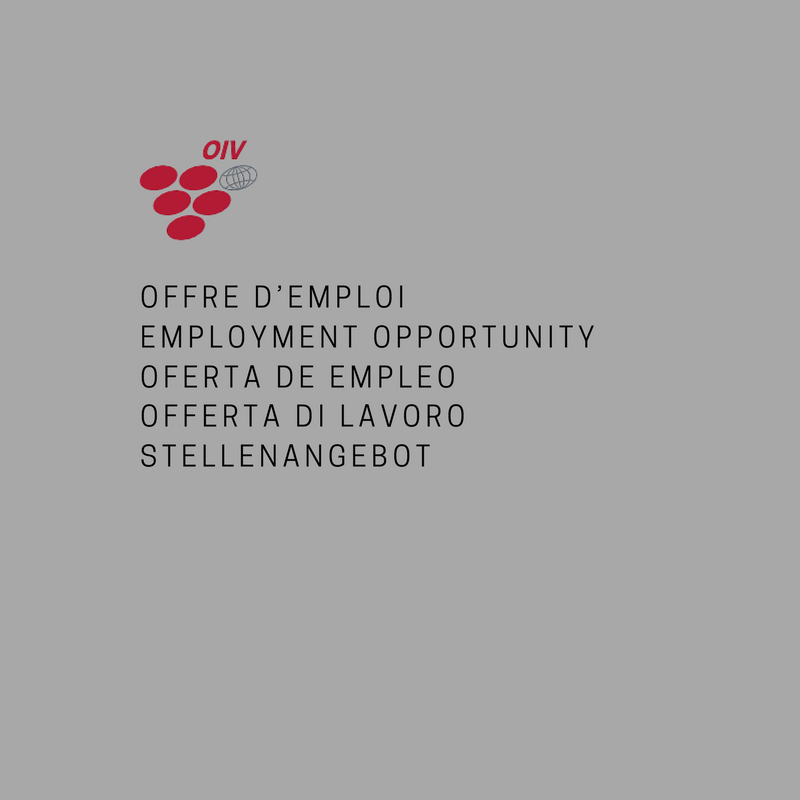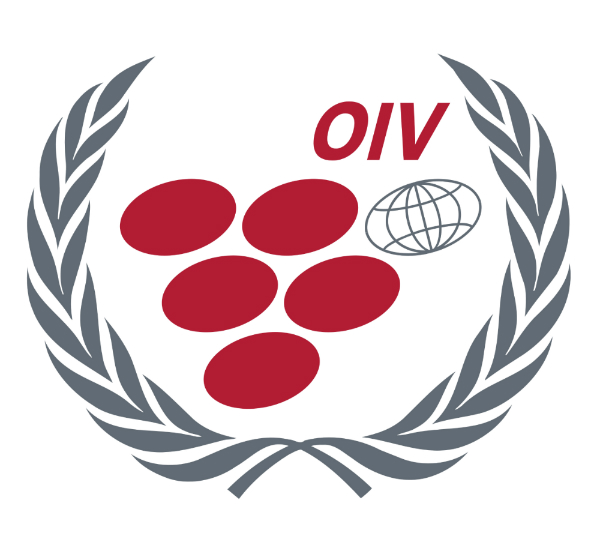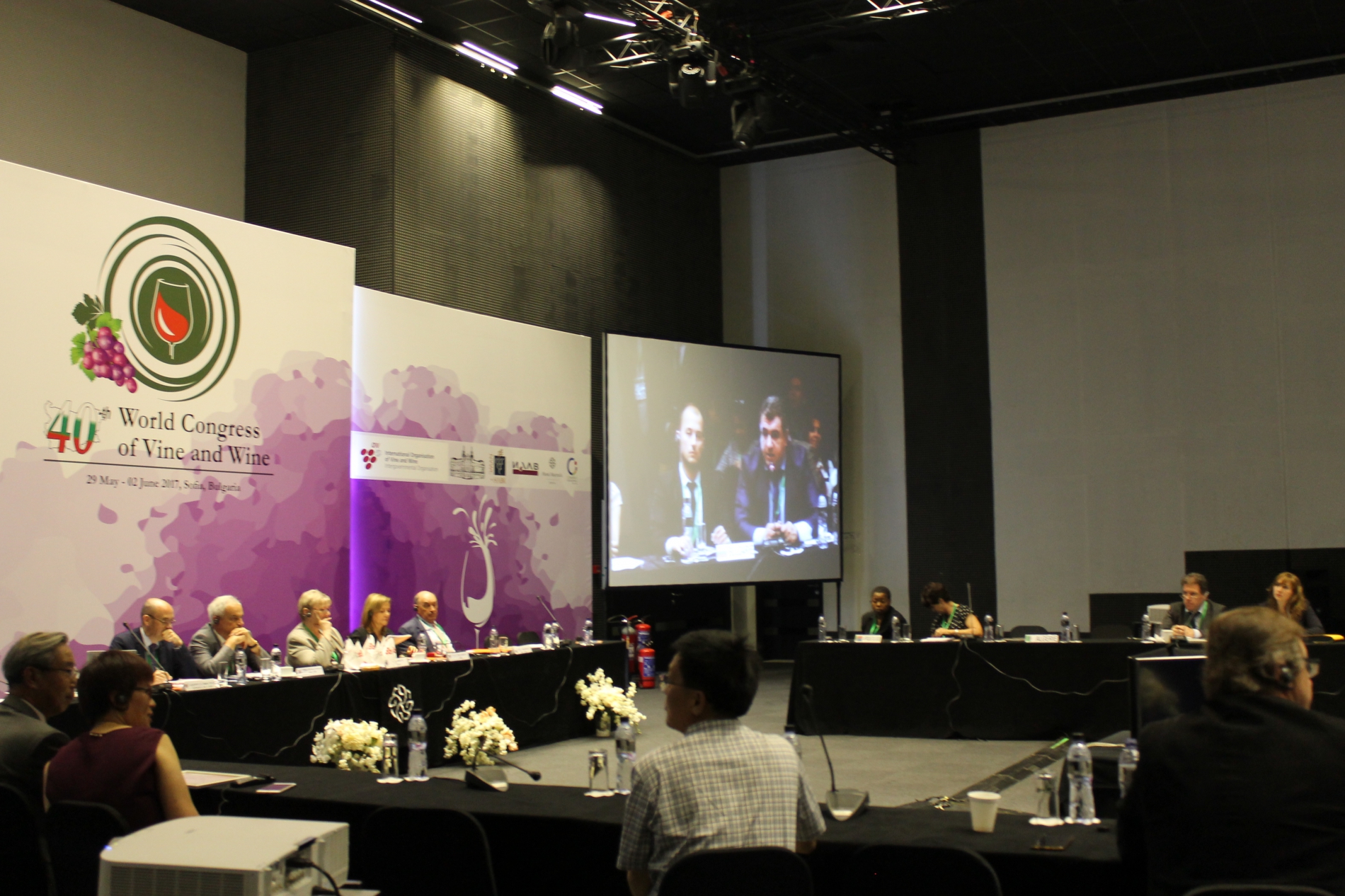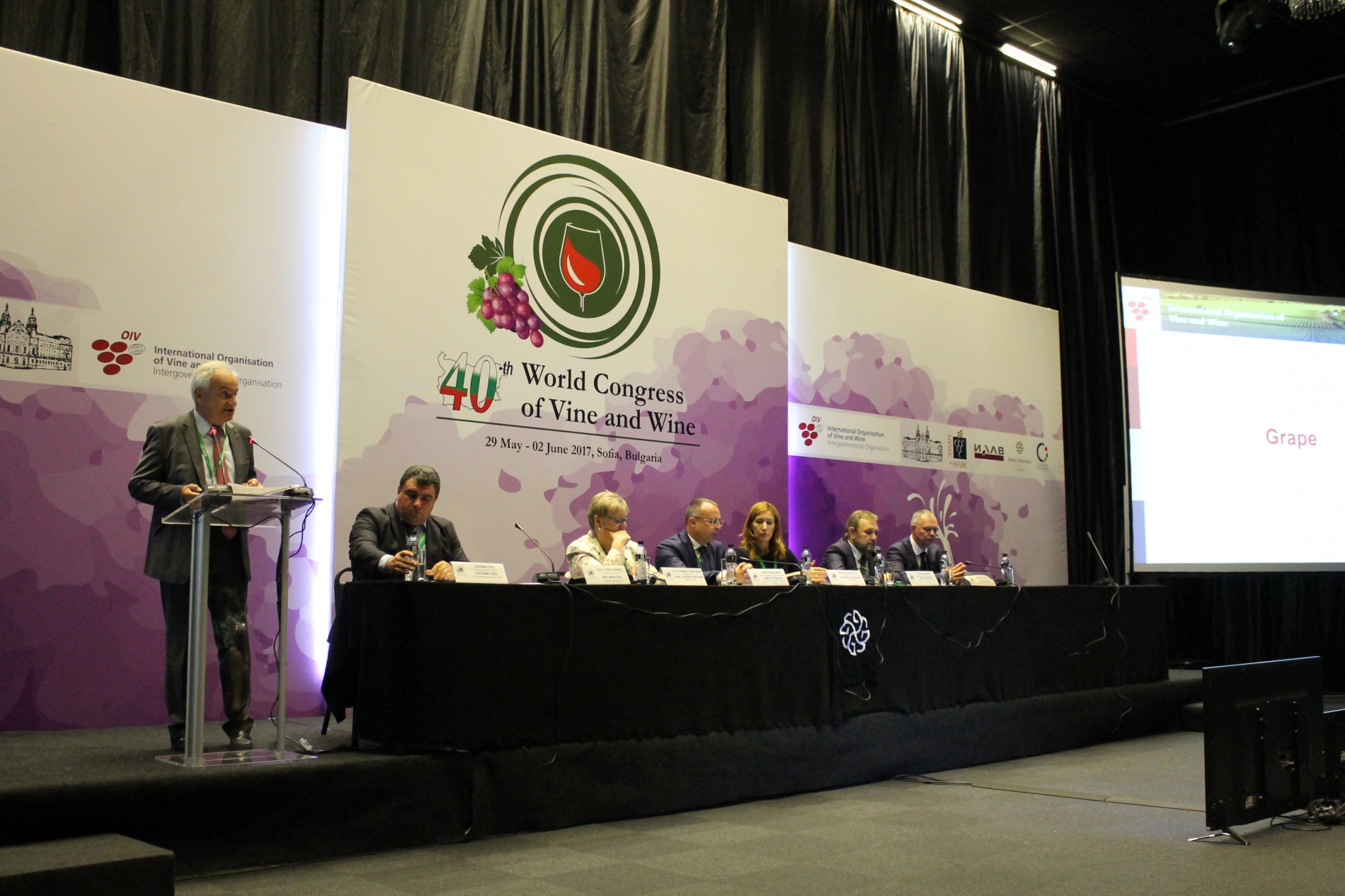18 июл 2017
Before the 123 Member States of the Codex Alimentarius – and within the framework of relations between the Codex Alimentarius Commission and other international organisations – Monika Christmann participated in the round table organised under the presidency of Dr Awilo Ochieng Pernet, President of the Codex Alimentarius Commission, regarding the collaboration between the Codex and other intergovernmental organisations, particularly within the field of sustainable development.The OIV President emphasised that the OIV was participating in several Codex projects under way and that it was actively involved, particularly in discussions concerning the provisions relative to food additives that appear in the General Standard for Food Additives (GSFA). She insisted on the need to ensure consistency among the standards of the Codex and those of the OIV, especially in relation to food additives used for grape wines. Additionally, she declared that the OIV paid close attention to the work of the Codex as well as that of the Joint FAO/WHO Expert Committee on Food Additives (JECFA) in order to avoid the duplication of work and the establishment of divergent international standards.With respect to sustainable development, the President indicated that the OIV had recently developed actions taking into account not only the agronomic aspect but also the economic and societal aspects.The OIV President concluded that it was necessary to pursue cooperation and coordination with regard to activities of common interest to the OIV and the Codex.Monika Chirstmann insisted on the need to ensure consistency among the standards of the Codex and those of the OIV, especially in relation to food additives used for grape wines
16 июл 2017
On this occasion, Monika Christmann gave a presentation on the situation of the world wine sector and its main development trends.She also addressed different subjects the OIV works on and that constitute such key issues for the future of vitiviniculture: environmental issues, sanitary concerns, labelling, etc.The OIV President praised the good collaboration with AREV, which benefits from observer status within the Organisation.Monika Christmann with the new AREV President, Emiliano García-Page Sánchez (from the Castilla-La Mancha region, Spain)The Assembly of European Wine Regions is an association that brings together the wine-producing regions in Europe (at a politico-professional level) and whose mission is to defend and promote European viticulture. It comprises 65 regions from 18 European countries.
05 июл 2017
During this meeting, the President and Director General of the OIV gave a presentation of the Organisation and welcomed the quality of relations maintained with the German authorities, as well as the high level of involvement of German experts in the work of the OIV.The Ambassador expressed his delight with this collaboration within a sector that not only plays an important economic role (Germany falls within the top 10 wine-producing countries and is the 4th biggest consuming country), yet also has a strong cultural and historic dimension.
02 июл 2017
Every year this event, placed under the patronage of the OIV and presided by Vitaly Merkushev, brings together actors in the vitivinicultural field from countries in the Black Sea area.400 participants, wine producers, oenologists, sommeliers, distributors, researchers, government representatives and journalists from 20 or so countries took part in this meeting, whose aim was to promote economic and technical cooperation by highlighting the common vitivinicultural characteristics of the region.During a conference dedicated to the implementation of a common working framework between the different actors, OIV Director General Jean-Marie Aurand gave a presentation on the major developments in the global vitivinicultural sector. This included a focus on the “spaces of convergence” of the vitivinicultural industry around the Black Sea, and the axes and actions for cooperation likely to be put in place.The presentation of wines organised as part of the Forum brought together over 70 companies.During the opening ceremony, Jean-Marie Aurand officially presented an OIV Merit Award to Lev Oganesyants, Director of the Russian Research Institute for Wine, Beer and Soft Drink Industries. Engineer, oenologist, teacher, researcher and then professor, elected in 2015 to the Russian Academy of Sciences, Lev Oganesyants has devoted his career to the vitivinicultural sector. The author of more than 350 scientific publications and 15 or so works including one on the history of the vine and wine field in Russia, which received a Special Mention from the OIV, for many years he was the Russian point of contact and official representative within the Organisation.The Director of the OIV expressed his heartfelt thanks to Professor Oganesyants for his continual and efficient actions to strengthen relations between the OIV and the Russian Federation.
26 июн 2017
The existing databases are currently processed autonomously in Excel and Access and are partially accessible and static on the OIV website.The objective is to have a permanent database that, in a second phase, can be used (for searches, status reports, graphs, etc.) both internally and on the OIV website through fun and configurable visual extractions.Recruitment conditionsApplication form
22 июн 2017
Forms and informationForm_Inscription_Livre_Book_JdP_2018.pdfForm_Inscription_numeric_JdP_2018.pdfInformation OIV Awards 2018Please note: journals and promotional and commercial documents are not accepted.A work (whether it has already won the award or not) may not be presented to the Award Jury for a second time.See details of the entries in the document " Information OIV Awards 2018".
12 июн 2017
Victor Magalhães passed away on 10 June 2017 at the age of 50 following a cerebrovascular accident that occurred during the closing dinner of the 40th OIV Congress in Sofia.It is with immense sorrow and great pain that we mourn the loss of Victor.He dedicated his entire career to the OIV, where he worked in the Secretariat for over 23 years.During all these years, he demonstrated a high level of professionalism and talent, having played an active role in compiling the statistical data published by the OIV every year. His experience, knowledge and expertise were recognised by all.But aside from his professional competence, Victor had strong, wonderful human qualities appreciated by all those who had the pleasure of meeting him.He set an example in terms of his energy and drive. It was with tremendous strength of character that several years ago he faced a serious illness and overcame the severe health problems he was affected by. Many, under these circumstances, would have thrown in the towel; Victor made the decision to resume his professional life and take on every challenge life threw at him with optimism.Victor had an endearing and highly empathetic personality. He was profoundly human, mindful of others, warm and altruistic. His optimism was infectious, and he loved to share his passion for football with his colleagues, as he also did with his son. Victor was appreciated universally.His passing has deeply affected his colleagues and friends at the OIV Secretariat who he mixed with on a daily basis, but also the wider OIV family.We express our deepest sympathies to his partner Paola, his son Léandro, his parents, his sister and all those close to him.We will not forget Victor.
06 июн 2017
Decisions on Viticulture and the Environment
- In the field of viticulture, the OIV adopted a standard protocol for the clonal selection of vine varieties (Resolution OIV-VITI 564A-2017) that takes into account the progress achieved in the areas of scientific research and diagnostic techniques, as well as the different criteria that exist within the OIV Member Countries. Among the different points of the protocol, the term 'selected clone' is defined. Likewise, a number of parameters are described regarding the cultivation capabilities of candidate clones for vine varieties, such as phenological data, sensitivity characteristics and/or factors affecting resistance characteristics, yield parameters and quality parameters.
- Official guidelines for recognising grapevine collections at an international level (Resolution OIV-VITI 539-2017). These guidelines propose a series of criteria to be met with a view to establishing an international standard designed to harmonise the criteria for, and utility and efficiency of genetic resources. Vine collections that comply with these criteria will benefit from the recognition of the OIV and inclusion on the OIV list of varieties and vine collections available on the Organisation's website.
- Treatment of musts with calcium sulphate for liqueur wines (Resolution OIV-OENO 583-2017). The objective of this practice is to develop liqueur wines that are balanced with regard to their taste sensations, to promote good biological evolution and satisfactory storage of liqueur wines, and to remedy insufficient natural acidity. The dose should not exceed 2 g/L calcium sulphate since this amount makes it possible to reach a pH of 3.2, which is a suitable level for the vinification of these musts. The residual sulphate content in the wines should not exceed the OIV limit
- Treatment of wines using selective plant fibres (Resolution OIV-OENO 582-2017). The objective of this practice is to reduce ochratoxin A levels in wines, as well as the number and levels of phytosanitary product residues detected in wines. Selective vegetal fibres are incorporated as processing aids, either during filtration with continuous deposition, or as a constituent of a filter sheet. The recommended dosage is determined according to the filtration technique used, without exceeding 1.5 kg/m2 of the filter sheet surface area.
- The treatment of musts with potassium carbonate, which has been permitted by the OIV within the context of the chemical deacidification of musts (Resolution OIV-OENO 580-2017). This new processing aid will be added to the list of products authorised for the reduction of the titratable acidity and the actual acidity.
- Treatment of musts and wines using inactivated yeasts with guaranteed glutathione levels (Resolutions OIV-OENO 532-2017 and OIV-OENO 533-2017). The objectives of these practices are to promote yeast metabolism through the provision of naturally-occurring nutritional compounds and to limit the oxidation of musts and wines by certain varietal aromatic compounds revealed by the metabolism of yeasts (particularly thiols). The dose used of glutathione – supplied directly or via yeasts with guaranteed glutathione levels – should not exceed 20 mg/L, in order to avoid any risk of reduction and the emergence of a yeast taste.
- An update to the monograph on Saccharomyces yeasts (Resolution OIV-OENO 576A-2017). Different forms of selected Saccharomyces yeasts may be used. Detailed specifications accompany this monograph, including the percentage of dry matter and the levels of viable yeasts according to the different forms. This monograph thus supplements the oenological practice.
- A monograph on non-Saccharomyces yeasts (Resolution OIV-OENO 576B-2017) used for the inoculation of grapes, musts and wines. As addition of non-Saccharomyces yeast might not result in the completion of alcoholic fermentation, inoculation with non-Saccharomyces yeasts may be followed by or complemented at the same time by inoculation with Saccharomyces spp. Detailed specifications accompany this monograph, including the percentage of dry matter and the levels of viable yeasts according to the different forms. This monograph thus supplements the oenological practice.
- An update to the monograph on tannins relating to the method for determination of polyphenols (Resolution OIV-OENO 574-2017). This method is designed to measure the polyphenol concentration of preparations of oenological tannins in polyphenols and is based on gravimetric analysis using solid-phase extraction (SPE).
- A monograph on glutathione that supplements the oenological practice (Resolution OIV-OENO 571-2017). Glutathione is used for its antioxidant properties that can fight against oxidation phenomena in musts and wines and protect aromatic compounds. Detailed specifications accompany this monograph, including that of the reduced glutathione content, which should be greater than 98%.
- A monograph on potassium polyaspartate (Resolution OIV-OENO 572-2017). Oenological potassium polyaspartate is exclusively prepared from L-aspartic acid. Detailed specifications accompany this monograph, including the degree of substitution of potassium salt, which should be at least 91.5% to guarantee optimal solubility.
- A monograph on selective plant fibres (Resolution OIV-OENO 578-2017). Selective plant fibres come from the edible parts of certain plants, generally of cereal origin. Selective plant fibres have a total insoluble parietal compound content of a minimum of 90% (m/m). Detailed specifications accompany this monograph, including the capacity for adsorption of certain pesticides, as well as that of ochratoxin A.
- A revision of the monograph on the PVI/PVP copolymer specifically relating to the maximum iron limit, which was brought up to 5 mg/kg of substance (Resolution OIV-OENO 605-2017).
- A method for the determination of 1,2-propanediol and 2,3-butanediol in musts and wines was adopted (Resolution OIV-OENO 589-2017). This method applies to the determination of the 1,2-propanediol and 2,3-butanediol that form after fermentation processes. These compounds are practically absent in unfermented musts, yet present in wine up to certain limits. The extracts are directly analysed via GC-MS on a polar column. The measurement is conducted according to the retention time and the mass spectrometer.
- A method of determination of the 13C/12C isotope ratio of glucose, fructose, glycerol and ethanol in products of vitivinicultural origin by high-performance liquid chromatography coupled to isotopic ratio mass spectrometry (Resolution OIV-OENO 479-2017). This type II method for glucose, fructose and glycerol and type III method for ethanol, based on the chemical oxidation of organic matter in CO2, makes it possible to determine the 13C/12C isotope ratio of the compounds using isotopic ratio mass spectrometry.
- A method relative to the determination of chitinase and thaumatin-like proteins in white wines (Resolution OIV-OENO 529-2017). This immunological method of semi-quantitative immunoprinting makes it possible to determine the presence or absence of unstable proteins in wines. Therefore, chitinase and thaumatin-like proteins can be detected from a total concentration of as low as 1 mg/L in wines.
- An update to the method of determination of ethyl carbamate (Resolution OIV-OENO 590-2017). The principle of this method is based on the determination of ethyl carbamate in spirituous beverages by gas chromatography/mass spectrometry (GC/MS) coupling. This method applies to spirituous beverages and spirits of vitivinicultural origin whose dry extract is either lower or higher than 20 g/L.
- On the one hand, there was the introduction of the definition of 'apparent alcoholic strength' (AAS) (Resolution OIV-OENO 587-2017), which is equal to the number of litres of ethanol contained in 100 litres of hydro-alcoholic mixture with the same density as that of the alcohol or spirituous beverage. Therefore, the AAS is directly deduced from the density of the product, without distillation. The AAS is expressed in % vol. On the other hand, there was the introduction of the principle of obscuration (Resolution OIV-OENO 588-2017), which is defined as the difference between the real alcoholic strength by volume and the apparent alcoholic strength, expressed in % vol.
- The OIV also adopted a recommendation for the establishment of training programmes for sommeliers (Resolution OIV-ECO 568-2017). Sommelier training programmes should guarantee that the sommelier acquires skills and is capable of diligently fulfilling the role as described in the Resolution OIV-ECO 474-2014. In accordance with the UNESCO International Standard Classification of Education (ISCED), the minimum sommelier training programme may be defined as a Level 4 post-secondary non-tertiary education programme or professional certification of equivalent level that prepares for entry into the labour market. The minimum duration will be 600 teaching hours distributed according to the specified curriculum.
- •Finally, the OIV adopted a resolution on the application of sustainable production principles in the production of distillates, brandies and spirituous beverages of vitivinicultural origin (Resolution OIV-ECO 501-2017). This document provides recommendations for the implementation of the five general principles of sustainable production in vitiviniculture, as they are defined in Resolution CST 518-2016. The document also covers the production process of distillates, brandies and spirituous beverages of vitivinicultural origin as they are defined in Part 1, Chapter 7 of the International Code of Oenological Practices.
01 июн 2017
Originality and high quality of the submitted works characterize this very fine 2017 OIV Awards Edition.Press release
2017 OIV AwardsViticulture AwardLa Vigne : ravageurs et auxiliaires - Volume 2Christian Linder, Patrick Kehrli, Olivier ViretFrançais / FrenchSuisse / SwitzerlandEditions AMTRA (Suisse)Œnology AwardIl respiro del vinoLuigi MoioItalien / ItalianItalie / ItalyMondadori Libri spa (Italia)Vitivinicultural Economy AwardIl Marketing del Vino - capire, decidere, agireMario Gregori, Luigi Galletto, Giulio Malorgio, Eugenio Pomarici, Luca RossettoItalien / ItalianItalie / ItalyEdiSES S.r.l. (Italia)History, Literature and Fine Arts AwardLe Vin & le SacréA l'usage des hédonistes, croyants ou libres penseursEvelyne MalnicFrançais / FrenchFranceEditions Féret (France)History AwardLes Femmes et la vigneUne histoire économique et sociale (1850-2010)Jean-Louis EscudierFrançais / FrenchFrancePresses Universitaires du Midi PUM (France)Wine and Health AwardWine Safety, Consumer Preference, and Human HealthCollectif d’auteurs coordonné par / Collective of authors coordonated by :Victoria Moreno-Arribas, Begoña Bartolomé SuáldeaAnglais / EnglishEspagne / SpainSpringer International Publishing (United States)Discovering and Presenting Wines AwardWine Tasting : A Professional Handbook, Third EditionRonald S. JacksonAnglais / EnglishCanadaElsevier (United States)Wines and Territories AwardPaisagens do Vinhedo Rio-GrandenseRinaldo Dal Pizzol, Luis Vicente Elias PastorPortugais / PortugueseBrésil / BrazilOrganização Doris Couto (Brasil)Wines and Gastronomy AwardVinárstvo & somelierstvoŠtefan AilerSlovaque / SlovakSlovaquie / SlovakiaAGRIPRINT s.r.o (Česká Republika)Monographs AwardNel solco degli emigrantiI vitigni italiani alla conquista del mondoIn the footsteps of migrantsThe Italian grapes that conquered the worldFlavia Cristaldi, Delfina LicataEdité en italien et en anglais / Printed in Italian and EnglishItalie / Italy / Italia / ItalienBruno Mondadori -Pearson (Italia)
2017 OIV Special MentionsViticulture special MentionZELENA KNJIGA : HRVATSKE IZVORNE SORTE VINOVE LOZECollectif d’auteurs avec / Collective of authors with :Edi Maletić, Jasminka Karoglan Kontić, Ivan PejićCroate avec introduction en anglais / Croatian with introduction in EnglishCroatie / CroatiaCroatian Agency for the Environment and Nature (Hrvatska)Œnology and Viticulture special MentionDe l’Œnologie à la ViticultureAlain Carbonneau, Jean-Louis EscudierFrançais / FrenchFranceEditions Quæ (France)Vitivinicultural Economy special MentionThe Wine Value Chain in ChinaConsumers, Marketing and the Wider WorldCollectif d’auteurs coordonné par / Collective of authors coordonated by :Roberta Capitello, Steve Charters, David Menival, Jingxue (Jessica) YuanAnglais / EnglishChine / ChinaElsevier (Asian Studies Series) and Griffith University (UK)Literature special MentionLe vin, entre nature & cultureAzélina Jaboulet-VercherreFrançais / FrenchFranceEditions Féret (France)Discovering and Presenting Wines special MentionA la rencontre des cépages modestes & oubliésL’autre goût des vinsAndré DeyrieuxFrançais / FrenchFranceEditions Dunod (France)Monographs special MentionChianti ClassicoThe Search for Tuscany's Noblest WineBill Nesto, Frances Di SavinoAnglais / EnglishEtats-Unis (Italie) / United States (Italy)University of California Press (United States)Symposia Proceedings special MentionEnologia Italiana del 1800Collectif d’auteurs coordonné par / Collective of authors coordinated by :Giusi Mainardi, Pierstefano BertaItalien / ItalianItalie / ItalyEdizioni OICCE – EO (Italia)Symposia Proceedings special MentionLes Rencontres du Clos-VougeotVin et civilisation, les étapes de l'humanisationCollectif d’auteurs dirigé par / Collective of authors directed by :Jocelyne Pérard, Maryvonne PerrotFrançais / FrenchFranceChaire UNESCO "Culture et Traditions du Vin" de l'Université de Bourgogne (France)
27 Май 2017
The report covers the vitivinicultural production potential, areas under vines, global wine production and consumption, and wine import and export volumes.In 2016, the world area under vines rose to 7.5 mha.Global grape production reached 75.8 mt in 2016.2016 world wine production (excluding juice and musts) is estimated at 267 mhl.World wine consumption in 2016 is estimated at 241 mhl.Press ReleasePPT PresentationOIV 2017 report Infrographics (initial information from the thematic report devoted to global vine diversity)
